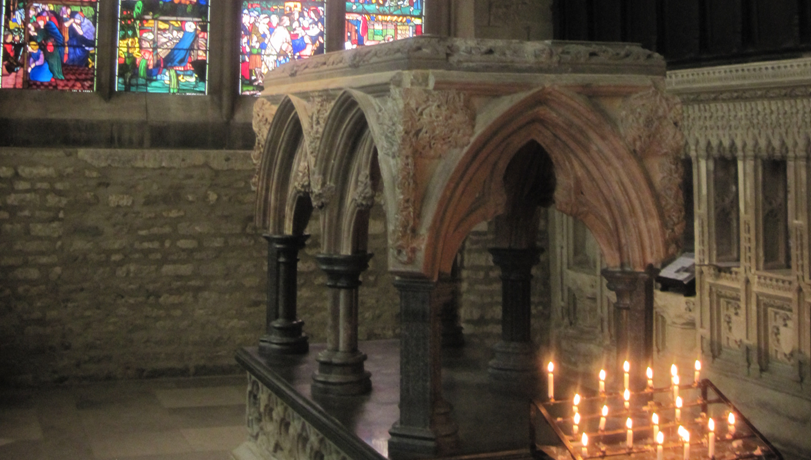This feast annually marks the official establishment of the Anglican Church in the United States and is therefore as important to Episcopalians as the arrival of St. Augustine in Kent is to the Church of England, and the whole Anglican Communion. Samuel Seabury is to the U.S. what St. Aidan was to Northumbria, what St. Columba was to the Picts, what St. Patrick was to the Irish, and, as said before, what St. Augustine was to the English. He was the missionary who finally secured the Apostolic line on America. And for this reason he is a man of 'blessed memory,' as St. Bede would have said it, to the Church in the United States.
Seabury grew up in the Colony of Connecticut and was ordained by the Bishop of London in 1753. He became a member of a missionary group in the colonies and successively served as Rector to the parishes of Christ Church New Brunswick, NJ, Grace Church Jamaica, NY, and St. Peter's Westchester County, NY. Both before and after the Revolutionary War, Seabury remained loyal to the Church of England and advocated for the establishment of a bishopric in the colonies. After the war, he was elected in a meeting of the Church in Connecticut to seek Episcopal consecration in England. He was denied consecration by the Archbishop of Canterbury because Church of England Bishops had to swear an oath to the king, which was problematic for the now American Seabury. So he sought consecration by the non-juror bishops of Scotland, who were in hiding because they refused to recognize the Hanoverian dynasty and, as Episcopalian in structure and catholic in worship, were suppressed by the Presbyterian Church of Scotland. The Scots agreed to consecrate Seabury on the conditions that they call themselves the 'Episcopal' Church, to get back at the Hanoverians in England, and that the Americans included the Epiclesis after the words of institution in the rite for Holy Communion. Seabury was consecrated on this day in 1784 by the bishop and suffragan of Aberdeen, and the bishop of Ross and Caithness in Aberdeen. He went on the establish the Church in Connecticut and Rhode Island, participated in the first consecration of a bishop in America, Claggett of Maryland, and served as the second Presiding Bishop of the Episcopal Church. He died in 1796 and in buried in St. James Church, New London.
 |
| Consecration of St. Samuel Seabury from St. Paul's Edinburgh. |
Collect:
Eternal God, you blessed your servant Samuel Seabury with the gift of perseverance to renew the Anglican inheritance in North America: Grant that, joined together in unity with our bishops and nourished by your holy Sacraments, we may proclaim the Gospel of redemption with apostolic zeal; through Jesus Christ, who lives and reigns with you and the Holy Spirit, one God, for ever and ever. Amen.
 |
| The miter of St. Samuel Seabury. |
THE rod that from Jerusalem
Went forth so strong of yore;
That rod of David's royal stem,
Whose hand the farthest bore?
St. Paul to seek the setting sun,
They say, to Britain prest:
St. Andrew to old Caledon;
But who still further West?
Go ask!--a thousand tongues shall tell
His name and dear renown,
Where altar, font, and holy bell,
Are gifts he handed down:
A thousand hearts keep warm the name,
Which share those gifts so blest;
Yet even this may tell the same,
First mitre of the West!
This mitre with its crown of thorn,
Its cross upon the front;
Not for a proud adorning worn,
But for the battle's brunt:
This helmet--with Salvation's sign,
Of one whose shield was faith;
This crown--of him, for right divine
Who battled unto death!
Oh! keep it--till the moth shall wear
Its comeliness to dust,
Type of a crown that's laid up where
There is nor moth nor rust;
Type of the LORD'S commission given
To this, our Western shore;
The rod of CHRIST--the keys of heaven,
Through one, to thousands more.
They tell how Scotia keeps with awe
Her old Regalia bright,
Sign of her independent law,
And proud imperial right;
But keep this too for Scotland's boast;
'Twill tell of better things,
When long old Scotia shall have lost
Those gewgaws of her kings.
And keep it for this mighty West
Till truth shall glorious be,
And good old Samuel's is confest
Columbia's primal see.
'Tis better than a diadem,
The crown that bishop wore,
Whose hand the rod of David's stem
The furthest Westward bore.


No comments:
Post a Comment